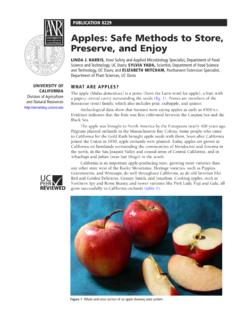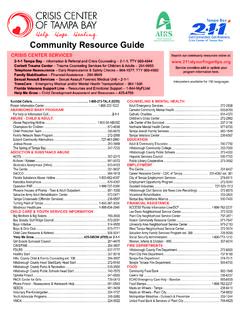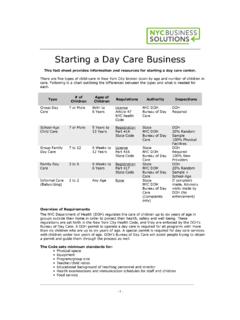Transcription of Fruit Trees: Training and Pruning Deciduous Trees
1 PUBLICATION 8057 UNIVERSITY OF CALIFORNIAD ivision of Agriculture and Natural INGELS, University of California Cooperative Extension Farm Advisor, EnvironmentalHorticulture, Sacramento County; PAMELA M. GEISEL, University of California CooperativeExtension Farm Advisor, Environmental Horticulture, Fresno County; CAROLYN L. UNRUH,University of California Cooperative Extension staff writerFruit Trees : Training and PruningDeciduous TreesThere are many ways to train and prune Deciduous Fruit Trees , and no single method isright for all situations and needs. When selecting Fruit Trees , one important considerationis the desired size of the Trees at maturity. Many people prefer small (dwarf and semidwarf) Trees because they are easier to manage and harvest and because more Trees can be grownin a limited space. Other people prefer full-sized Trees because they provide more shadeand more Fruit per unit DWARF TREESG enetic dwarf Trees usually produce very short internodes (the space on a shoot betweentwo leaves), resulting in compact branches with dense foliage.
2 These Trees grow to about 8 to 10 feet ( to m) tall and wide at maturity. They make beautiful landscape treesthat are easily managed to provide adequate amounts of Fruit for a single family. Excellentvarieties are available in peaches, nectarines, and apples. The lower and interior fruitingbranches of genetic dwarf Trees , especially peaches and nectarines, tend to die quickly dueto shading by the dense growth. However, the Trees are small, so production of Fruit on theextremities of the higher branches is not a serious problem as long as the branches arestrong enough to hold the weight of the genetic dwarf Trees mainly involves thinning the branches in the dormantseason to open up the canopy and maintain the height and spread of the tree. Control treesize and strengthen limbs by removing branches at their point of attachment to the trunkor a larger branch (thinning cuts), rather than by heading or topping them.
3 For defini-tions of Pruning terms, refer to the AND SEMIDWARF TREESFull-sized Trees on standard rootstocks can grow to 25 to 30 feet ( to m) tall, whiletrees on semidwarfing rootstock can reach 15 to 20 feet ( to m) tall. Both standardand semidwarf Trees can be kept relatively small by Pruning , but Trees of this size may stillgrow too large for many backyard situations. An excellent selection of truly dwarfing applerootstocks is usually available, and truly dwarfing rootstocks are being developed for mostfruit species. Depending on the type of tree (growth habit and location of fruiting buds),full-sized and semidwarf Trees may be trained to an open center , central leader, or fruitbush center SystemThe open center , or vase-shaped, system (fig. 1) is most commonly used on almond, apri-cot, cherry, fig, nectarine, peach, plum, and prune Trees . Many pear, apple, and pistachiotrees are also trained to this system.
4 With this method, the center of the tree is kept free oflarge branches and vigorous upright shoots (suckers and watersprouts) in order to allowsunlight to reach the lower fruiting growing season. To create an open center tree, in about late April of the firstgrowing season select three or four shoots that will become the primary scaffold branches(main structural branches) and pinch back all other strong upright shoots to 4 to 6 inches(10 to 15 cm) long. When possible, these scaffold branches should be spaced severalinches apart vertically and should be distributed evenly around the trunk, with the low-est branch about 18 to 24 inches (46 to 60 cm) above the ground. If growth is vigorous,the selected scaffold branches should be pinched back or headed to about 2 to 21 2feet(60 to 75 cm) long in late May or early June (or when growth is long enough) to pro-mote side branching and the development of secondary scaffold branches.
5 Continue topinch or head back unwanted branches but leave lateral shoots for next year s Fruit pro-duction. These unwanted branches will be removed later, but they provide shade for thetrunk and main branches of young Trees during the current growing season. If summerpruning was not done or was insufficient, create the open center during the dormant sea-son. Continue to develop secondary scaffold branches in subsequent growing dormant season after three or four primary scaffold branchesif this was not done the previous summer. Do not select scaffold limbs that grow directlyabove one another. Avoid upright limbs that are attached with narrow, acute anglesbecause they tend to be weak at the point of attachment. Flat or horizontal limbs shouldbe avoided as scaffold limbs, but they can be used if new shoots coming from them aredirected upward and outward. For most species, a 45 angle for limb attachment is mostdesirable.
6 If the tree grows poorly the first year, severely head back the primary scaffoldsto three or four buds to promote vigorous growth the next year and correct the causes ofthe poor , plum, and pear Trees produce very upright growth. To promote tree spread,the scaffolds should be bent outward while still flexible or cut back to outside lateralbranches. Other Trees , such as apricots, peaches, and almonds, have a spreading growthhabit and tend to produce lateral branches without heading. With these varieties it isoften necessary to remove flatter-angled branches and leave more upright branches, thusmaintaining the upward, outward growth the mature or pinching the primary scaffold branchesencourages secondary scaffold branches to grow from them. Allow two to three sec-ondary branches to develop from each primary. Remove all other strong branches, prefer-ably during the summer, to reduce competition with the scaffold branches and provide2 ANR Publication 8057 Figure 1.
7 open center Pruning method. (A) Bare root tree at planting time. (B) Tree headed after planting. (C) Growth after oneseason. (D) Tree pruned after one growing to lateral fruiting branches and spurs. Head or pinch the secondary scaffoldbranches at 2 to 21 2 feet (60 to 75 cm) long to develop two to three tertiary branchesfrom each secondary branch. Ideally, two branches should originate from each primaryand secondary, and they should grow upward and outward but away from each , shoot growth seldom conforms to this Trees . Pruning mature open center Fruit Trees involves keeping the centerfree of vigorous upright shoots, reducing tree height, and thinning out branches toreduce crowding. For peaches and nectarines, select 1-year-old lateral fruiting branchesthat originate close to main branches. Thin these fruiting branches (one-third to one-halfof them can be removed) and head them by one-third if they are longer than about 1 to 2feet (30 to 60 cm).
8 Remove or cut back 2-year-old fruiting shoots or cut them back to 1-year-old shoots. On other species, old fruiting spurs should be renewed periodically. Table 1 shows the location of fruiting buds, the longevity of spurs, and the desired sever-ity of Pruning of selected species. When dormant Pruning , become familiar with theplump fruiting buds and prune accordingly to ensure adequate flowering the followingspring. Pruning of mature almonds involves few or no heading cuts; simply thin outbranches often fairly large branches to prevent Leader SystemCentral leader Training (fig. 2) is often used for apples and sometimes for pears, Asianpears, pecans, and quince. These Trees tend to have dominant central leaders, a character-istic that lends itself to the central leader trainingmethod. However, because many apple and pear vari-eties are susceptible to fire blight, open center or othermultiple-leader methods are often preferred so that if amajor limb is lost the tree can be more easily redevel-oped.
9 Central leader Training involves keeping treesshaped somewhat like Christmas Trees , with lateralbranches arranged in separate layers, or tiers, sepa-rated by open areas of canopy, and branches in lowertiers wider than those in upper ones. Instead of sun-light reaching lower fruiting branches through the cen-ter, as with the open center method, it reaches themfrom the sides and between young central leader Trees , the goal is to cre-ate three or four tiers of lateral branches, with aboutfour branches per tier. This is done preferably duringspring and summer by heading back (and later remov-ing) or bending down any vigorous shoots that growupright and compete with the central leader. Create thefirst tier of four lateral branches by tying or stakingbranches outward at an angle just above horizontalafter they have grown 2 to 3 feet (60 to 90 cm) the central leader has reached about 21 2to 3feet (75 to 90 cm) past the first tier, usually in the firstdormant season after planting, head it just below thispoint and train a second tier of four branches outwardfrom the cut leader.
10 These branches should be offsetvertically from those of the first tier. Allow the mostvigorous upright shoot to continue its growth as thecentral leader. Then create the third tier in a similarmanner. Avoid bending one branch directly over anoth-3 ANR Publication 8057 Figure 2. Central leader Pruning method. (A) Bare root tree atplanting time. (B) First tier of scaffold branches and reestablishedcentral leader. (C) First tier of branches staked into desired posi-tion as second tier of branches is established. Branches devel-oped in the third (D) and subsequent (E) years are spaced evenlyaround and up the central leader. Note the 45 angle of branchattachment formed by using spreading ; also, maintain the tree s pyramidal shape by keeping lower branches longer thanupper branches. The entire process will take 3 to 4 years, depending on the tree s side branching of these main lateral branches should be encouraged.







